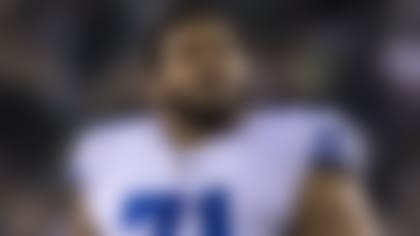The 2014 NFL Draft is just days away. As such, Around The League is breaking down the best draft class of all time for each AFC team. Look for the breakdown of each NFC team here.
AFC East
Buffalo Bills
If you ever doubt the virtuosity of Bill Polian, consider the history of the Bills franchise before and after his arrival on the scene. Outside of back-to-back AFL championships in 1964-65, the Bills' only taste of success has been the Polian-constructed span of 1988-96 -- featuring four Super Bowl appearances and eight playoff berths in nine seasons.
Following general manager Terry Bledsoe's February heart attack, pro personnel director Polian and chief college scout Norm Pollom began splitting duties leading up to the 1985 NFL Draft. Armed with nine picks in the first five rounds, the duo ended up building the backbone for the AFC's dominant team of the next 10 years.
Smith is not only the best defensive player in franchise history, but also the NFL's career leader in sacks and member of the NFL's All-Decade Team for the 1980s and 1990s. Finally elected to the Hall of Fame early this year, Reed earned seven consecutive Pro Bowl selections and owns every relevant Bills receiving record.
Along with Earl Morrall, George Blanda and Don Strock, third-round pick Frank Reich belongs in the discussion for top backup quarterbacks of all time. He led the Bills on a 38-3 run to overtake the Oilers in the NFL's largest-ever comeback before handing the reins to Jim Kelly for Super Bowl XXVII.
The '85 draft also produced deep threat Chris Burkett, three-time Super Bowl champion Dale Hellestrae and future NFL broadcaster Ron Pitts.
Miami Dolphins
The first round of the 1983 NFL Draft was a "transformative" moment for the league, as outlined in ESPN's 30 for 30 documentary "Elway to Marino" The Steelers' decision to pass on hometown hero Marino in favor of Texas Tech defensive lineman Gabriel Rivera changed the course of two franchises.
The '83 class gets the nod primarily on the strength of the Marino-to-Clayton connection that took the NFL by storm in 1984. Both players set single-season records for touchdowns at their respective positions before falling to the 49ers in Super Bowl XVIII. At one point in time, the Marino-Clayton tandem was the most prolific in NFL history.
Already boasting the prodigious "Marks Brothers," the Dolphins' aerial attack would have featured 12th-round pick Anthony Carter had they not traded the USFL superstar's rights to the Vikings in 1985.
That offensive prowess shouldn't overshadow the impact of one of the handful of African American punters in NFL history. Roby played 16 seasons as a three-time Pro Bowl selection and one of the premier punters of his era.
Fun fact: The 1970 draft featured separate trades that netted the Dolphins future Hall of Fame selections Paul Warfield and Nick Buoniconti in exchange for first- and fifth-round picks, respectively.
New England Patriots
For an organization that has dominated the AFC for a decade and a half, the Patriots surprisingly lack a definitive, franchise-altering draft class. If not for Aaron Hernandez's fall from grace, the 2010 class featuring Rob Gronkowski, Devin McCourty and Brandon Spikes would offer that potential.
The 1995 class not only helped propel the Patriots to Super Bowl XXXI versus the Packers, but also teamed with the 1996 class (Lawyer Milloy, Tedy Bruschi, Terry Glenn) to lay the groundwork for a trio of Lombardi Trophies in 2001, 2003 and 2004.
A member of the 2000 All-Decade Team, Ty Law produced a 47-yard interception return for a touchdown that was integral to the shocking upset over the Rams in Super Bowl XXXVI. Starting linebacker Ted Johnson helped the Pats to four Super Bowl appearances in 10 seasons.
Although Curtis Martin went on to a Hall of Fame career, his Patriots career was cut short in 1998 when the Jets signed him away with help from contract consigliere Mike Tannenbaum's "poison pill" innovation.
New York Jets
If the 1964 and 1965 drafts were combined into one mega class, they would be the runaway winners for the Jets. Without those two drafts featuring Joe Namath, running back Matt Snell and defensive ends Gerry Philbin and Verlon Biggs, there would have been no Super Bowl III "guarantee" and subsequent upset over the heavily-favored Colts.
In other words, the NFL-AFL merger would have gone down quite differently.
The 1977 class helped the Jets reach the playoffs four times, including the 1982 AFC Championship Game.
One of three Jets players (Joe Namath, Don Maynard) to have his number retired, the versatile Klecko was a key member of the famed "New York Sack Exchange" defensive line that generated 66 sacks in 1981.
In addition to being one of the most decorated linemen in Jets history, Powell wrote a newspaper column and was elected president of the NFLPA during his playing days. A career Jet, Walker remains second only to Maynard on many of the franchise receiving records.
The '77 group also produced a 13-year starter, the backfield tandem that succeeded John Riggins and the 1978 starter at quarterback.
Fun fact: Klecko is the only player to be named to the Pro Bowl at three different positions (defensive end, defensive tackle and nose tackle).
AFC North
Baltimore Ravens
Ranked No. 6 on NFL Network's list of the Top 10 draft classes of all time, the first draft in Ravens history set the tone for one of the most consistently successful franchises over the past two decades.
In the conversation with Dick Butkus for greatest middle linebacker in NFL history, Ray Lewis was at the heart of two Super Bowl champions. The other first-round draft pick, Jonathan Ogden, rivals Orlando Pace and Walter Jones as the premier left tackle of an era that inspired best-selling author Michael Lewis' "Blindside."
Not to be overlooked, fifth-round draft pick Jermaine Lewis generated six punt-return touchdowns in his career, highlighted by an eye-popping 16.1 yards per return during the 2000 Super Bowl season.
Fun fact: Until Torrey Smith in 2011, the Ravens failed to draft a single wide receiver capable of recording a 1,000-yard season in Baltimore.
Cincinnati Bengals
It was No. 5 overall pick Greg Cook, though, who would have cemented this draft as the franchise's best had the golden-armed 1969 AFL Rookie of the Year not lost his promising career to a shoulder injury.
Although the 1984 draft produced Boomer Esiason and three more starters from Super Bowl XXIII, it doesn't match the star power of the 2001 class with two of the most productive wide receivers in franchise history, a leading rusher and a premier defensive end.
Fun fact: All-Pro defensive end Mike Reid, the Bengals' first-round pick in 1970, left the game at the height of his powers to become a country music singer who would end up in the Nashville Songwriters Hall of Fame.
Cleveland Browns
After watching the NCAA's best athlete letter in lacrosse, basketball, track and football at Syracuse, five teams passed on the greatest running back in NFL history. Despite hanging up his spikes to chase an acting career, Jim Brown led the NFL in rushing a record eight times and was rated the No. 2 player of all time by NFL.com in 2009.
Brown wasn't the only Hall of Fame selection from the 1957 class, though. With six Pro Bowl nods in 15 seasons, guard Gene Hickerson earned a bust in Canton in 2007. Drafted in the fifth round, defensive tackle Henry Jordan went on to a Hall of Fame career with Vince Lombardi's Packers after being traded for Bob Jarus.
Drafted at No. 17 overall, Milt Plum's 110.4 passer rating in 1960 stood as a record for 30 years until Joe Montana's (112.4) career year in 1989.
Fun fact: The 1978 draft produced Hall of Fame tight end and current Ravens general manager Ozzie Newsome plus 19-year linebacker Clay Matthews, father of the Green Bay Packers star.
Pittsburgh Steelers
The consensus pick as the greatest draft class in NFL history, the 1974 Steelers class boasts four Hall of Fame selections and another two-time Super Bowl champion.
A rangy middle linebacker and bone-crushing hitter, Lambert was the final key to Bud Carson's Cover-2 scheme that produced the Steel Curtain defenses responsible for four Lombardi trophies.
Swann and Stallworth were one of the most dynamic wide-receiver duos of the 1970s. Before his life devolved into tragedy, Webster was viewed as Jim Otto's primary competition for the greatest center of all time.
Without the '74 class, there is no Steelers dynasty.
Fun fact: From 1969 through 1974, the Steelers drafted at least one Hall of Famer in every year save 1973.
AFC South
Houston Texans
For pure historical impact, the 2003 and 2011 drafts featuring Andre Johnson and J.J. Watt stand out. The problem is the lack of depth in those two classes.
Armed with the No. 1 overall pick in 2006, Charlie Casserly eschewed playmaking scat back Reggie Bush and bucked conventional wisdom by selecting pass rusher Mario Williams. It was the correct call. Although Williams shuffled off to Buffalo via the richest contract for a defensive player in history, he remains the Texans' all-time leader in sacks.
That same class also produced the 2006 Defensive Rookie of the Year (Ryans), the best tight end in franchise history (Owen Daniels) and a six-year starter at right tackle (Winston).
Fun fact: Fresno State's David Carr was the first pick in Texans' history back in 2002. His younger brother, Derek Carr, could be the organization's second-round pick in next week's draft.
Indianapolis Colts
The 2003 class (Robert Mathis, Dallas Clark, Cato June) propelled Indianapolis to its only Super Bowl victory. The loaded 2012 class has the potential to go down as one of the greatest offensive drafts in history.
We have to go back to Baltimore in 1963, however, to find the franchise's most decorated draft class.
John Mackey and Mike Ditka were unanimously viewed as the best tight ends ever to take the field until Kellen Winslow introduced the new breed in the 1980s. Five-time Pro Bowl offensive tackle Bob Vogel protected Johnny Unitas blindside for a nearly decade. Jerry Logan was one of the premier playmaking safeties of his era. Willie Richardson was a first-team All-Pro as Johnny U's top target in 1967.
On the strength of the '63 stars, the Colts won one Super Bowl and made the trip to two other championship games in the 1960s.
Jacksonville Jaguars
There's no obvious candidate for the best class in Jaguars history. The 2002 draft produced quarterback David Garrard, defensive tackle John Henderson and linebacker Akin Ayodele. The 1996 draft turned up pass rushers Kevin Hardy and Tony Brackens in addition to cornerback Aaron Beasley.
For the franchise's best, I'd nominate the first one that featured NFL 1990s All-Decade Team left tackle Tony Boselli. If Jimmy Smith isn't the greatest player ever to suit up for the Jaguars, it's Boselli.
The Jaguars also picked multiyear starters in running back James Stewart, middle linebacker Bryan Schwartz, guard Brian DeMarco and safety Chris Hudson.
Thanks to a solid draft and veteran pickups such as Smith, Keenan McCardell and Mark Brunell, the Jaguars avoided the pitfalls of almost every other expansion team in history.
Fun fact: Fourth-round pick Rob Johnson was traded three years later for a first-round draft pick that was used to select Fred Taylor, the franchise's rushing leader.
Tennessee Titans
The Titans lack a historical draft class, which leaves the Houston Oilers responsible for the top handful of drafts in franchise history.
The highlight is the 1987 haul that allowed Warren Moon to excel in the signature run-and-shoot attack of the early 1990s.
Operating out of a four-wide spread, Haywood Jeffires and Curtis Duncan combined for 837 receptions and 10,054 yards from 1987 to 1995. On the other side of the ball, linebacker Al Smith perennially led the team in tackles while notching a pair for Pro Bowl appearances.
Fun fact: Fifth-round pick Spencer Tillman played 115 games in the NFL, but is best known an analyst on CBS' "College Football Today."
AFC West
Denver Broncos
The Orange Crush defense that drove the Broncos to Super Bowl XII was largely constructed via the loaded draft classes of 1973 and 1975.
If we include the blockbuster trade that sent John Elway to Denver, though, the 1983 draft had greater impact on the franchise's legacy.
That draft produced the dominant offensive player (Elway) and defensive player (linebacker Karl Mecklenburg) on the 1980s Broncos that appeared in a trio of Super Bowls. Elway went on to win a pair of Super Bowl rings after the "Snow Goose" retired.
Fun fact: The 1983 draft also produced Gary Kubiak, who backed up Elway for nearly a decade before finding a measure of success as the winningest coach in Texans history.
Kansas City Chiefs
There's no debating the 1963 class' merit as the finest in Chiefs' history, as it laid the groundwork for one of the greatest defenses the NFL has seen.
The early 1960s Chiefs of Lamar Hunt and Hank Stram got a jump on the rest of the football world, targeting the best players from historically black colleges in the South. At a time when professional football kept an unofficial quota on African Americans, Stram's club fielded a defense filled with black stars such as Hall of Fame players Buck Buchanan and Bobby Bell.
In addition to those two, the '63 group featured All-Time All-AFL guard Ed Budde and long-time right tackle Dave Hill. The 11th round also turned up Jerrel Wilson, the greatest punter in AFL history as well as the longest-tenured Chief.
Those five players would go on to notch an AFL championship in 1966 and the Super Bowl title in 1970.
Oakland Raiders
The Raiders played in six conference championship games during the 1970s, due in large part to the contributions of the 1968 draft class.
Ken Stabler was the AFC's answer to Roger Staubach, as an improvising scrambler who often came through in the clutch. He was protected by Hall of Fame selection Art Shell, left tackle on the 1970s All-Decade Team.
The draft also produced backfield stars Marv Hubbard and Charlie Smith, forming one of the NFL's most potent tag-teams of the early 1970s. Not to be forgotten is hard-hitting safety George Atkinson, who famously rendered Lynn Swann unconscious with a forearm smash to the back of the head in 1976.
Fun fact: When Raiders owner Al Davis was suing the NFL in 1982, one owner stationed a parrot trained to squawk "F you, Al Davis" at the entrance to the league's annual meeting.
San Diego Chargers
Former Bolts general manager A.J. Smith deserves plenty of credit for the 2001, 2004 and 2005 draft hauls that generated LaDainian Tomlinson, Drew Brees, Philip Rivers, Shaun Phillips, Michael Turner, Vincent Jackson, Darren Sproles and Shawne Merriman.
For the best class in franchise history, though, we have to go back to 1975 for a trio of defensive stars that added bite to the Chargers' "Air Coryell" offense.
The first three rounds turned up Hall of Fame pass rusher Fred Dean and All-Pro defensive tackles Gary "Big Hands" Johnson and Louie Kelcher. That mammoth defensive line, coined the "Bruise Brothers," wreaked havoc on the AFC West, combining for 60 sacks in 1980 before Dean forced a trade to the 49ers.
Fun fact: Dreaded for giving opponents a "Louie Kelcher hangover," the 6-foot-6, 285-pound defensive tackle sported size 16 1/2 EEEE cleats and a 16.5 ring finger.
The latest "Around The League Podcast" breaks out the crystal ball and predicts the potential surprises that could shake up the NFL Draft.












